The state of Oklahoma is home to at least 24 different species and subspecies of salamanders. Most of these salamanders are terrestrial, which means they live on land. But there are also several fully aquatic salamander species.
Terrestrial salamanders prefer to live in moist habitats and are typically found in shady, forested areas, not far from a water source – and often hide in moist locations such as under rocks, logs, and other debris.
Many of these salamanders are most active in the spring, so that is when you are most likely to encounter them.
Native Salamanders of Oklahoma
As mentioned earlier, Oklahoma is home to at least 24 species of salamander, some species more common than others.
Since there are so many salamander species, the exact size and coloration varies between species. They range in size from 2 inches to as large as 30 inches! (depending on the species).
If you ever spot a salamander in the state of Oklahoma, It’s probably one of these. You can potentially see salamanders of any age or gender!
1. Spotted Salamander (Ambystoma Maculatum)


| Average Adult Size (Length) | 6 – 9 inches |
| Average Lifespan (Years) | 15 – 20 |
Spotted salamanders (sometimes called “yellow-spotted salamanders“) are fairly large, ranging from 6 to 9 inches long, with females typically larger than males.
These salamanders get their name from the two roles of yellow or orange spots speckled along their black backs and sides.
Some spotted salamanders have orange spots on the head, while the spots on the body are more yellow in color. The underside is pale gray with no spots.
These salamanders have broad heads and thick, heavy bodies with vertical grooves on each side of their body
In Oklahoma, spotted salamanders are only found in the eastern part of the state.
Spotted Salamander Range. Map By: United States Geological Survey.

2. Mole Salamander (Ambystoma Talpoideum)

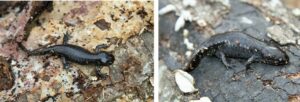
| Average Adult Size (Length) | 3 – 4 inches |
| Average Lifespan (Years) | 10 – 20 |
Mole salamanders are stout-bodied salamanders that grow 3 to 4 inches in length. They have short bodies and large, flattened heads that may look somewhat disproportional to the rest of their body.
These salamanders typically have a gray or dark brown coloration with pale bluish or silvery mottling and light gray undersides.
In Oklahoma, mole salamanders are only found in the southeastern corner of the state.
Mole Salamander Range. Map By: United States Geological Survey.

3. Marbled Salamander (Amybstoma Opacum)


| Average Adult Size (Length) | 3 – 5 inches |
| Average Lifespan (Years) | 8 – 10 |
Marbled salamanders are fairly small, only growing 3 to 5 inches in length from snout to tail.
These salamanders are dark gray to black with silvery crossbands running along with their chunky bodies. Because of this appearance, they are sometimes called “banded salamanders“.
Male marbled salamanders are typically smaller than females and have whitish crossbands that become very white in the breeding season.
In Oklahoma, marbled salamanders can be found throughout the southeastern part of the state.
They have been documented in LeFlore, Latimer, Pushmataha, Atoka, Choctaw, McCurtain, and Adair counties.
Marbled Salamander Range. Map By: United States Geological Survey.

4. Eastern Tiger Salamander (Ambystoma Tigrinum Tigrinum)
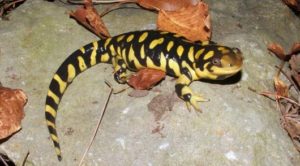
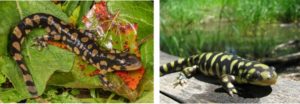
| Average Adult Size (Length) | 6 – 9 inches |
| Average Lifespan (Years) | 15 – 25 |
Eastern tiger salamanders typically range from 6 to 9 inches but can grow up to 13 inches, which makes them the largest terrestrial salamanders in Oklahoma.
These salamanders can be easily identified by their dull brown coloration, with olive-yellow to brownish-yellow irregular blotches (“tiger stripes”), and a yellow underside.
Some eastern tiger salamanders may have brilliant golden yellow or light brown blotches, while others may be extremely dark with very little noticeable patterning.
In Oklahoma, these salamanders are very rarely encountered. They are only found in the extreme southeastern part of the state.
Eastern Tiger Salamander Range. Map By: United States Geological Survey.
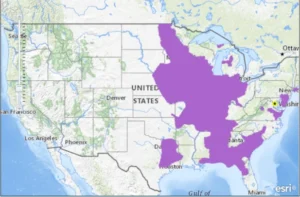
5. Barred Tiger Salamander (Ambystoma Mavortium)

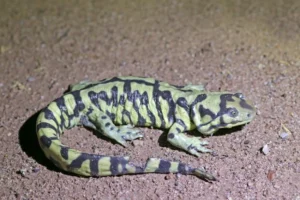
| Average Adult Size (Length) | 6 – 9 inches |
| Average Lifespan (Years) | 15 – 25 |
Barred tiger salamanders are sometimes called “western tiger salamanders”. As their name suggests, these salamanders are subspecies of tiger salamander and are very closely related to the Eastern tiger salamander.
Barred tiger salamanders grow 6 to 9 inches in length and have a gray, dark brown, or black coloration, with olive-yellow to brownish-yellow irregular bars and spots. The underside is yellow.
Since these salamanders look very similar to the eastern tiger salamander, the main way you can tell these two subspecies apart is by their coloration:
- Eastern tiger salamanders have lots of yellow spots or blotches on their body
- Western tiger salamanders have few yellow blotches, and the botches frequently form “bars”
Barred Tiger salamanders are distributed throughout much of the western half of Oklahoma.
Barred Tiger Salamander Range. Map By: United States Geological Survey.
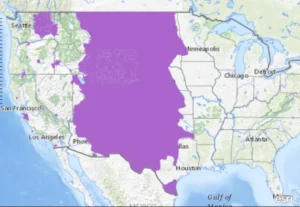
6. Smallmouth Salamander (Ambystoma Texanum)
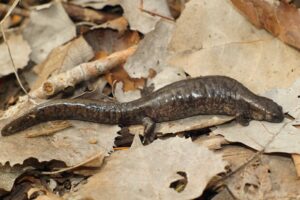
| Average Adult Size (Length) | 4.3 – 7 inches |
| Average Lifespan (Years) | 15 – 20 |
Smallmouth salamanders are sometimes called “narrow-mouthed salamanders”. They range between 4.3 and 7 inches in length and can be best identified by their small head with a blunt, short snout. The head tends to appear swollen behind the eyes.
These salamanders have a brownish-gray to grayish-black coloration with light gray speckles of lichen-like blotches, particularly along the lower sides of the body. The underside is of the same color with little or no speckling.
Smallmouth salamanders are found throughout much of eastern and central Oklahoma.
Smallmouth Salamander Range. Map By: United States Geological Survey.
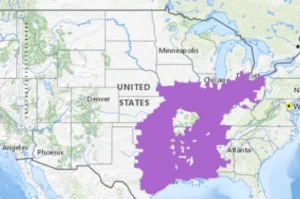
7. Western Slimy Salamander (Plethodon Albagula)
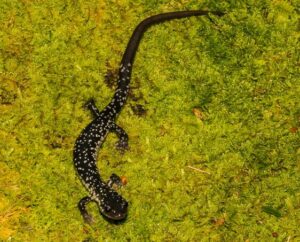
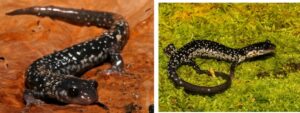
| Average Adult Size (Length) | 4 – 7 inches |
| Average Lifespan (Years) | 15 – 20 |
Western slimy Salamanders are fairly large salamanders reaching about 4 to 7 inches in length, with the tail about 70 percent as long as the body.
Like other slimy salamanders, this species has a black to bluish-black coloration with widely scattered white or brassy flecks.
This flecking pattern varies among individuals and may occasionally merge to create a white, highly mottled pattern along the sides of the body. The belly is typically colored a uniform black.
Slimy salamanders get their name from the very sticky mildly toxic goo they secrete when threatened. This goo sticks to the predator’s mouth enabling the salamander to escape.
In Oklahoma, western slimy salamanders are restricted to the eastern parts of the state.
Western Slimy Salamander Range. Map By: United States Geological Survey.

8. Kiamichi Slimy Salamander (Plethodon Kiamichi)


| Average Adult Size (Length) | 4 – 7 inches |
| Average Lifespan (Years) | 15 – 20 |
Kiamichi slimy salamanders are a subspecies of slimy salamander, so they are very closely related to the Western Slimy.
Like other slimy salamanders, these salamanders have a black to bluish-black coloration with widely scattered white or brassy flecks.
This flecking pattern varies among individuals and may occasionally merge to create a white, highly mottled pattern along the sides of the body. The belly and chin are dark gray.
Kiamichi slimy salamanders are only found in the Kiamichi Mountains and Round Mountains of Le Flore County, eastern Oklahoma, and Polk County, western Arkansas, respectively.
However, the true extent of their range is not known as this subspecies has not been extensively studied.
Kiamichi Slimy Salamander Range. Map By: United States Geological Survey.
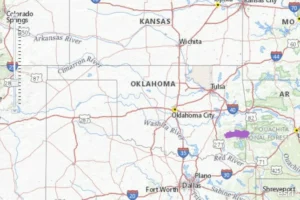
9. Sequoyah Slimy Salamander (Plethodon Sequoyah)

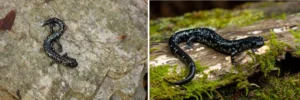
| Average Adult Size (Length) | 4 – 7 inches |
| Average Lifespan (Years) | 15 – 20 |
As the name suggests, this is another subspecies of slimy salamander and is very closely related to the western and the Kiamichi slimy salamander.
Like other slimy salamanders, Sequoyah Slimy salamanders grow 4 to 7 inches in length and have a black to bluish-black coloration with widely scattered white or brassy flecks.
These salamanders are only known from Beavers Bend State Park in Oklahoma. However, they may also possibly be found outside the park and even in a small portion of extreme southwestern Arkansas.
Sequoyah Slimy Salamander Range. Map By: United States Geological Survey.
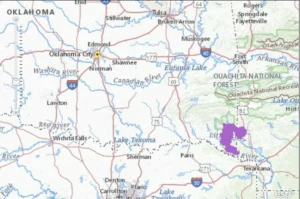
10. Ringed Salamander (Ambystoma Annulatum)

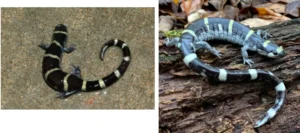
| Average Adult Size (Length) | 5 – 7 inches |
| Average Lifespan (Years) | Unknown, but estimated to be 10 – 15 |
Ringed salamanders typically range from 5 to 7 inches but occasionally grow up to 9 and a half inches in length.
These salamanders have a dark blackish-brown color and get their name from the series of bold, narrow white or yellow rings that extends over the back.
There is variation in the intensity of the markings, and they may be broken at the midline. The belly is a pale grayish white
Looking from the top, the tail and body can appear to be completely ringed – however, the rings never completely encircle the body.
Ringed salamanders have a slender and elongated build, and usually have 15 rib-like grooves on the sides of their body.
In Oklahoma, these salamanders are only found in the eastern parts of the state.
Ringed Salamander Range. Map By: United States Geological Survey.
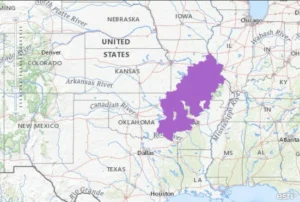
11. Southern Red-Backed Salamander (Plethodon Serratus)

| Average Adult Size (Length) | 2 – 5 inches |
| Average Lifespan (Years) | 15 – 20 |
Southern Red-backed salamanders have slender bodies and reach between 3 and 4 inches in length. They are typically gray or black in color – and despite their name, not all “red-backed ” salamanders have the color red on their backs.
They have many color variations but mainly have two variations: The red-back, and the lead- morph.
The red-back morph has a straight-edged reddish stripe (sometimes orange, yellow, or dark gray) running the length of its back from the base of the head to the tail, with dark sides. The lead-back morph, on the other hand, lacks the red stripe. It has a purely dark gray to-black color on its back instead.
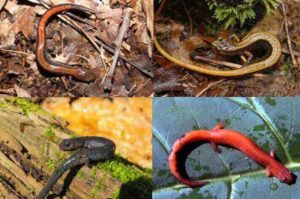
In Oklahoma, southern red-backed salamanders are found in the eastern parts of the state and are fairly common around the Ouachita Mountains.
Southern Red-Backed Salamander Range. Map By: United States Geological Survey.
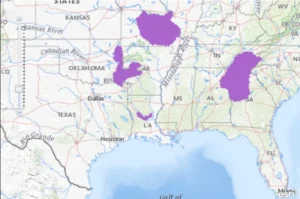
12. Oklahoma Salamander (Eurycea Tynerensis)
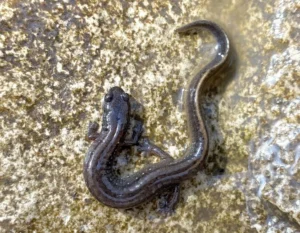

| Average Adult Size (Length) | 1– 4 inches |
| Average Lifespan (Years) | Unknown, but estimated to be 5 – 10 |
Oklahoma Salamanders are fairly small, slender salamanders only growing between 1 and 4 inches in length.
They generally have a yellowish-tan to dark brown or gray coloration and usually have a yellow-tan to brown dorsal stripe running along their back. 19-21 rib-like grooves are present on the sides of their body.
The belly is grayish-yellow and small white flecks are present along the sides and tail.
Oklahoma salamanders are found in the Northeastern edge of the state of Oklahoma. However, they are also found in southwestern Missouri and northern Arkansas.
Oklahoma Salamander Range. Map By: United States Geological Survey

13. Four-Toed Salamander (Hemidacylium Scutatum)


| Average Adult Size (Length) | 2 – 4 inches |
| Average Lifespan (Years) | Unknown, but estimated to be 8 – 12 |
Four-toed salamanders range from 2 to 4 inches in length. They get their name from the four toes on both their front and hind feet. No other salamander species has 4 toes on each foot (most salamanders have five toes on the back feet).
Four-toed salamanders have a reddish-brown or gray-brown coloration on the back, with gray sides and a white belly with black spots.
These salamanders also have an obvious constriction at the base of the tail where it can detach if grabbed by a predator, allowing the salamander to escape.
In Oklahoma, four-toed salamanders are only found in the Southeastern parts of the state. However, they are not very frequently encountered.
Four-Toed Salamander Range. Map By: United States Geological Survey.

14. Rich Mountain Salamander (Plethodon Ouachitae)
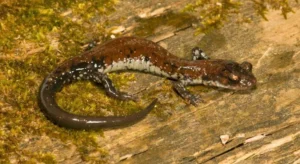
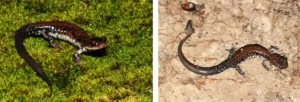
| Average Adult Size (Length) | 2 – 4 inches |
| Average Lifespan (Years) | Unknown, but estimated to be 8 – 12 |
Rich mountain salamanders grow between 2 and 4 inches in length. They have a mottled and slatey-gray coloration which helps them camouflage and blend into their environments.
The salamanders have whitish-gray flecking on the sides – the chin is gray and the belly is a uniform grayish-black.
Rich mountain salamanders were first collected at Rich Mountain east of Page, Oklahoma in the Ouachita Mountains.
Since then, they have been found to also occur on five other mountains; Buffalo, Winding Stair, Black Fork, Kiamichi, and Round Mountain.
Rich Mountain Salamander Range. Map By: United States Geological Survey
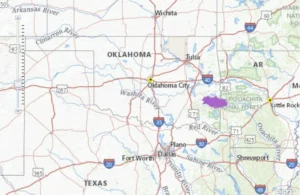
15. Ozark Zigzag Salamander (Plethodon Angusticlavius)
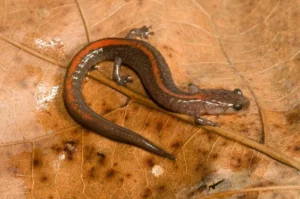
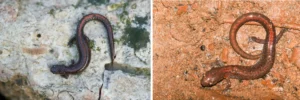
| Average Adult Size (Length) | 2 – 4 inches |
| Average Lifespan (Years) | Unknown, but estimated to be 8 – 15 |
Ozark zigzag salamanders are fairly small, only growing 2 -4 inches in length. They have dark gray or brownish-gray sides with some orange or red and small white flecks.
A narrow mid-dorsal stripe (usually less than one-third the width of the body) runs along the back and is widest near the hind limbs.
The dorsal stripe usually has irregular or wavy edges and may be yellow, yellow-orange, orange, or red. Sometimes, dark brown pigment may invade the stripe, making it look lobed, or it may cover a large part of the stripe.
The belly has white and black mottling and there are 17–19 rib-like grooves on the sides of the body.
Ozark Zigzag Salamanders are often confused with the southern red-backed salamanders. However, a simple way you can tell them apart is:
- The dorsal stripe of the southern red-backed salamander is uniform in width, wider, and has serrated (toothed) edges.
While,
- The dorsal stripe of the Ozark Zigzag Salamander has non-uniform width with the widest part being near the hind limbs, is generally narrower, and has wavey edges.
Ozark Zigzag Salamanders are found throughout the Ozark Plateaus Province, from northwestern Arkansas to the eastern edge of Oklahoma and the southern tip of Missouri.
Ozark Zigzag Salamander Range. Map By: United States Geological Survey
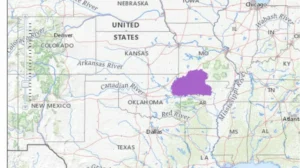
16. Many-ribbed Salamander (Eurycea multiplicata)

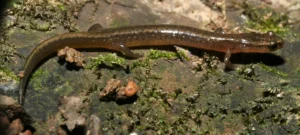
| Average Adult Size (Length) | 2 – 3 inches |
| Average Lifespan (Years) | Unknown, but estimated to be 5 – 1o |
Many ribbed salamanders are small, only measuring 2 – 3 inches in length. There is a broad brown stripe running from the head down the back.
The back may have small dark brown chevrons marking the grooves on the back. The belly is pale gray to lemon yellow.
In Oklahoma, many-ribbed salamanders are found in the eastern parts of the state where they hang around caves and associated spring flows. However, they are not frequently encountered.
Many-Ribbed Salamander Range. Map By: United States Geological Survey
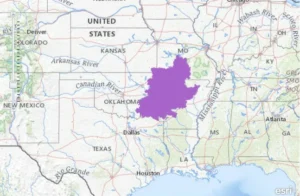
17. Cave Salamander (Eurycea Lucifuga)
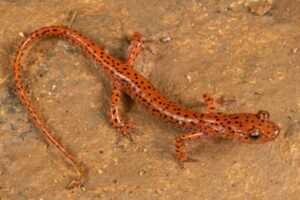
| Average Adult Size (Length) | 5 – 8 inches |
| Average Lifespan (Years) | 15 – 20 |
Cave salamanders, sometimes called spotted-tail salamanders, are relatively large, ranging from 5 to 8 inches in length. They have a slender body and long tail that accounts for 60-65% of their total length.
They have a bright reddish-orange to a bland yellow coloration and irregular black spots scattered around their body and tail.
Despite their name, cave salamanders are not restricted to caves, and may be found in forests near bluffs and rocky crevices and around springs, and also under moist rocks and logs at some distance from caves.
They are also typically found in areas with exposed limestone cliffs or other rock faces with cracks serving as retreats – in northeastern Oklahoma.
Cave Salamander Range. Map By: United States Geological Survey
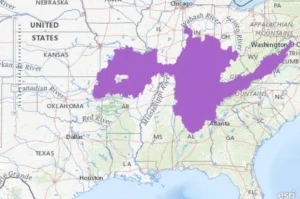
18. Ouachita Dusky Salamander (Desmognathus Brimleyorum)
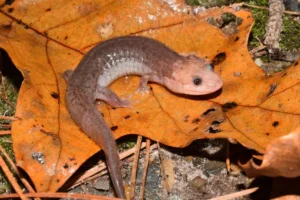
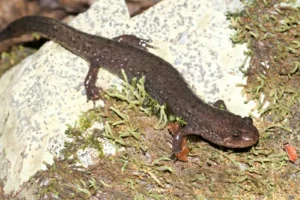
| Average Adult Size (Length) | 4 – 7 inches |
| Average Lifespan (Years) | 10 – 15 |
Ouachita dusky salamanders are fairly stout and grow between 4 to 7 inches in length, with a finned tail.
They have a varied coloration, but they are generally a fairly uniform greenish-brown or gray and have fourteen costal rib grooves on either side of their body. Juveniles also have a row of pale spots along each side.
As in all dusky salamander species, their back legs are visibly larger than the front.
In Oklahoma, Ouachita dusky salamanders are found in the southeastern parts of the state – where they live in and near mountain streams and the ravines and woodland close by, and near springs.
Ouachita Dusky Salamander Range. Map By: United States Geological Survey

19. Dark-Sided Salamander (Eurycea Longicauda Melanopleura)
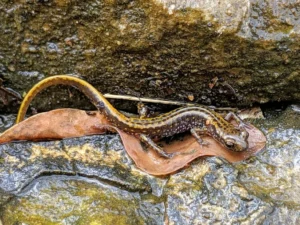
| Average Adult Size (Length) | 4 – 7inches |
| Average Lifespan (Years) | 5 – 10 |
Dark-sided salamanders vary from 4 to 6 inches in total length. They have thin bodies with broad heads, large eyes that protrude well above the head, and relatively long legs.
They have a yellow to orange coloration, and the body, tail, and legs are covered with irregular black markings. The lower sides of the body are white with black markings.
Black markings along the sides of the body where the background color changes from yellow or orange to white form an irregular black stripe that extends from the eye, down the side of the body, and down the tail.
The thin tail is considerably longer than the body and is slightly laterally compressed. There are 13 -14 rib-like grooves on the sides of the body.
Dark-sided salamanders are easy to confuse for cave salamanders, but a simple way to tell apart is by their coloration:
- Cave salamanders are usually red or orange with black spots.
In Oklahoma, dark-sided salamanders are found in the northeastern parts of the state.
20. Western Grotto Salamander (Eurycea Spelaea)

| Average Adult Size (Length) | 3 – 5 inches |
| Average Lifespan (Years) | Unkown |
Western grotto salamanders are sometimes called “Ozark blind salamanders.” They typically grow between 3 and 5 inches in length and adults have a pale tan to pale pink coloration.
Their heads are rather wide and flat. The tail is long and slender – and there are 16–19 grooves along the side of the body.
Western grotto salamanders live in caves and are partly or completely blind. Their eyes are small and reduced, covered or partially covered by a fusion of the eyelids. The eyes may also appear sunken into the head.
In Oklahoma, Western grotto salamanders are found in the northeastern parts of the state.
As larvae, they live in springs and streams near cave entrances. However, as adults, they migrate deep into the caves themselves and live out their lives underground.
Newts in Oklahoma
Salamanders are often informally divided into two groups: “Newts” and “true salamanders”.
True salamanders typically have smooth moist skin while newts tend to have more rough, grainy skin. In simple terms, newts are a specific type of salamander.
There is only one species of newt that is native to the state of Oklahoma
21. Central Newt (Notophthalmus Viridescens Louisianensis)
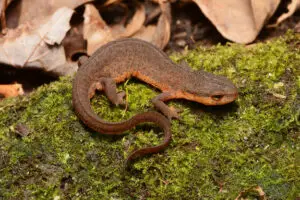
| Average Adult Size (Length) | 2 – 4 inches |
| Average Lifespan (Years) | 12 -15 |
Central newts are a subspecies of the eastern newt. They grow between 2 and 4 inches in length and have an olive-brown coloration with fine black dots all over the body. Some individuals may have very small red spots bordered with black along the back on both sides of the spine.
The underside is a bright orange-yellow and is noticeably lighter than the rest of the body.
In the Juvenile eft stage (which lasts about 3 to 4 years), central newts have a dull brown to reddish-brown coloration with a rounded tail.

As adults, their tail is less rounded and is paddle-shaped to help them swim as these newts are highly aquatic.
Central newts are found throughout the eastern one-third of Oklahoma, but their distribution is spotty. They are often found not very far from a water source.
Eastern Newt Range. (Central Newt Range Is in Purple).

Aquatic Salamanders in Oklahoma
Unlike terrestrial salamanders, aquatic salamanders live entirely in the water, even after transforming into adults. This means they have features that are adapted for life in the water, rather than on land.
Aquatic salamanders have more varied features than terrestrial salamanders. Some aquatic salamanders have 4 legs, but others only have forelegs and lack hind legs. Some have gills, but others do not and largely breathe underwater through their skin.
However, despite their varied features, all aquatic salamanders have flat paddle-like tails which they use to swim in their aquatic environments.
There are three aquatic species of salamander in the state of Oklahoma.
22. Red River Mudpuppy (Necturus Louisianensis)

| Average Adult Size (Length) | 6 – 9 inches |
| Average Lifespan (Years) | Unknown, but estimated to be 15 – 30 |
Red River Mudpuppies reach 6 to 9 inches and are one of the few salamanders that are vocal. Mudpuppies get their name from their squeaky scream which sounds somewhat like a dog’s bark.
They have 4 small well-developed legs (two forelegs and two hind legs) which they use to slowly walk on the bottoms of streams or ponds. The legs can be flattened against the body to give them a more streamlined body during short swimming spurts. Each of their feet has four toes.
Their coloration is generally dark brown or tan with many dark spots that do not continue to the belly.
Red River Mudpuppies are found in northeastern Oklahoma, southeastern Kansas, southern Missouri, Arkansas, and north central Louisiana.
As their name suggests, they live only in the Red River and adjacent drainage systems
23. Western Lesser Siren (Siren Intermedia Nettingi)

| Average Adult Size (Length) | 7 – 27 |
| Average Lifespan (Years) | 20 – 30 |
Western lesser sirens typically range from 7 to 27 inches in length. They have a gray to brown to nearly black coloration with a lighter belly. Individuals with lighter coloration often have small dark spots scattered on the head and back.
These salamanders have an eel-like appearance with a flat paddle-like tail. They have external feathery gills that resemble ostrich plumes, and two very small forelegs (they do not have hind legs). Each of the forelegs has 4 toes.
The name “lesser” comes from the fact that these sirens are typically smaller than greater sirens; lesser sirens are usually less than 2 feet in total length – in contrast, greater sirens frequently exceed 3 feet in total length.
Western lesser sirens can be found in slow-moving rivers, canals, and other calm water bodies – in the southeastern corner of Oklahoma.
Lesser Siren Range. Map By: United States Geological Survey.
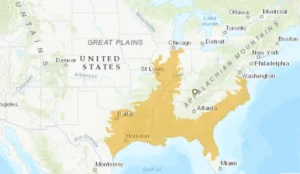
24. Three-Toed Amphiuma (Amphiuma Tridactylum)

| Average Adult Size (Length) | 18 – 30 inches |
| Average Lifespan (Years) | 15 – 20. |
Three-toed amphiumas are slender eel-like aquatic salamanders that typically grow between 18 and 30 inches in length – which makes them the largest salamanders in Oklahoma.
They have four small inconspicuous vestigial legs, one pair just behind each side of the neck and another pair just ahead of the longitudinal anal slit.
However, they don’t use these to walk. When out of the water, they move in a snake-like pattern and use their legs as balancing organs. They get their name from the three toes on each of their feet.
Unlike the sirens, amphiumas do not have external gills, but rather have lungs to breathe air from the surface of the water and can breathe underwater through their skin.
In terms of coloration, three-toed amphiumas are uniformly brown or dark gray to almost black with a light gray or light brown color on their belly that extends onto the sides.
These salamanders can be found in calm or slow-moving freshwater bodies in the southeastern corner of Oklahoma.
Three-Toed Amphiuma Range. Map By: United States Geological Survey.

Conclusion
Oklahoma has 24 salamander species & subspecies, with some being more widely distributed and more common their others.
Most of Oklahoma’s salamanders are terrestrial – which means they live on land, but there are also three fully aquatic species.
There are salamanders small enough to fit in the palm of your hand, but they’re also large salamanders such as the Three-Toed Amphiuma that can reach 30 inches in length!
If you want to see these salamanders, go looking in moist locations such as under rocks, logs, and other debris. You are most likely to find them in the spring months when they are most active.


